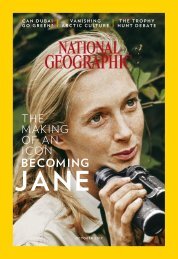NC
Create successful ePaper yourself
Turn your PDF publications into a flip-book with our unique Google optimized e-Paper software.
| EXPLORE | ANIMALS<br />
SO THAT’S WHY<br />
THE LONG FACE<br />
By Jeremy Berlin<br />
Let’s face it: When it comes to expressions,<br />
a horse is no one-trick pony.<br />
Recent findings have revealed that our<br />
equine friends use 17 discrete facial<br />
movements to communicate. That’s 10<br />
fewer than humans—but one more than<br />
dogs and four more than chimpanzees.<br />
Researchers at the University of Sussex<br />
discovered this by dissecting a horse<br />
head and identifying the musculature<br />
below its facial features. Then they<br />
watched behavioral footage—15 hours<br />
of video showing 86 male and female<br />
horses, from a variety of breeds, ranging<br />
in age from four weeks to 27 years.<br />
The last step was to use a tool called<br />
EquiFACS (Equine Facial Action Coding<br />
System) to catalog the eye, lip, nostril, and<br />
chin movements they’d observed. The<br />
result: a gestural map that suggests evolutionary<br />
parallels among varied species.<br />
Jennifer Wathan, the study’s lead<br />
author, says the similarities between<br />
horse movements and human ones are<br />
striking. They include raising inner eyebrows<br />
(“puppy-dog eyes”) to show fear,<br />
surprise, or sadness; pulling back lip corners<br />
(smiling) in greeting or submission;<br />
and opening eyes wide to indicate alarm.<br />
Wathan says these findings can help<br />
us better understand interspecies relationships.<br />
Systems like EquiFACS “create<br />
a common language to objectively make<br />
comparisons across species—even those<br />
with totally different-shaped faces.”<br />
Her team’s research, which is already<br />
helping veterinarians and trainers, could<br />
also connect facial expressions to emotional<br />
states. “We don’t know much<br />
about the emotional lives of animals,”<br />
she says. “What does a positive emotion<br />
look like? This tool could help us see it.”<br />
An Arabian horse looks<br />
around its stable in the<br />
United Arab Emirates.<br />
Horses are visual animals—<br />
they see better than cats<br />
and dogs—with communication<br />
skills that evolved to<br />
keep family groups together.<br />
PHOTO: TIM FLACH



